- Books Name
- Class 6 Mathematics Book
- Publication
- ReginaTagebücher
- Course
- CBSE Class 6
- Subject
- Mathmatics
Chapter - 4
Basic Geometrical Ideas
Introduction to geometry
Geometry has a long and rich history. The term 'Geometry' is derived from the Greek word 'Geometron'. Geometry is the branch of mathematics which deals with the measurement, properties and relationships of points, lines, angles, surfaces and solids. So here we are going to learn about,
1. Points
2. Line segment
3. Line
4. Ray
5. Plane
6. Intersecting Lines
7. Parallel Lines
8. Curves
9. Polygon,
10. Angle
11. Triangle
12. Quadrilaterals,
13. Circle and its parts
Point and line segment
In geometry, dots are used to represent points. A point is used to represent any specific location or position. It neither has any size, nor dimensions such as length or breadth. A point can be denoted by a capital letter of the English alphabet. Points can be joined in different ways.

Line segment :
A line segment is defined as the shortest distance between two points. A line segment has two end points and a hence a definite length. For example, if any two points, M and N are marked on a sheet of paper, then the shortest way to join M to N is a line segment. It is denoted by ––––MNMN_ and ––––NMNM_. Points M and N are the end points of the line segment.
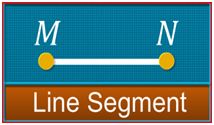
Line and ray
Line :
A line is made up of an infinite number of points that extend indefinitely in either direction. Two points determine a line. For example, if a line segment from M to N is extended beyond M in one direction and beyond N in the other, then we get a line, MN. It is denoted by←−→ MN MN↔. A line can also be represented by small letters of the English alphabet.

Ray:
A ray is a portion of a line. It starts at one point and goes on endlessly in one direction. For example, if a line from A to B is extended endlessly in the direction of B, then we get a ray, AB. It is denoted by −−→ABAB→and can be read as ray AB.

Plane:
A plane is said to be a very thin flat surface that does not have any thickness, and is limitless. A plane is always represented by a minimum of three points.
For example, the sheet shown below is said to be plane ABC. An infinite number of points can be contained within a plane.

Intersecting lines and parallel lines
Intersecting lines:
If two lines pass through a point, then we say that the two lines intersect at that point. Thus, if two lines have one point in common, then they are called intersecting lines. Intersecting lines always intersect, cut or cross each other. For example, If two lines pass though a point P, then the two lines are called intersecting lines.

Parallel lines or non- intersecting lines:
In a plane, if two lines have no point in common, then they are said to be parallel or non- intersecting lines. Parallel lines never meet, cut or cross each other. Parallel lines never meet, cut or cross each other. If two lines m1 and m2 are parallel, we write m1 || m2.

Curve and it types
Curves:
Curves can be defined as figures that flow smoothly without a break. A line is also a curve, and is called a straight curve.

Simple curves:
Curves that do not intersect themselves are called simple curves.

Open curves
Curves whose end points do not meet are called open curves.
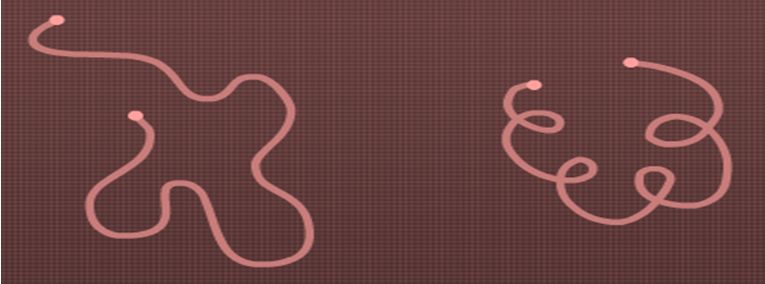
Closed curves:
Curves whose end points join to enclose an area are called closed curves.

For a closed curve, we can identify three regions

The interior of the curve: Green points are in the interior of the closed curve.
Boundary of the curve: Blue points are on the boundary of the closed curve.
Exterior of the curve: Red points are in the exterior of the closed curve.
The interior of a curve together with its boundary is called its “region”.
Polygon
Collinear Points
Three or more points are said to be collinear, if there is a line which contains them all.

In the above figure; P, Q, R are collinear points.
5. INTERSECTING LINES
Two lines having a common point are called intersecting lines. The point common to two given lines is called their point of intersection. In the figure, the lines AB and CD intersect at a point O.
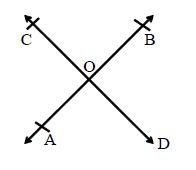
6. PARALLEL LINES
Two lines l and m in a plane are said to be parallel, if they have no point in common and is written as l || m. The distance between two parallel lines always remains the same.

POLYGONS
Simple closed curves made up of only line segments are called polygons. Line segments that form the polygon are the sides of the polygon. Any two sides with a common end point are called the adjacent sides. The point of intersection of a pair of sides is called a vertex. The end points of the same side are adjacent vertices. The line segment joining any two non-adjacent vertices of a polygon is a diagonal. ABCDEF is a polygon.
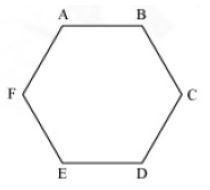
The line segments AB, BC, CD, DE, DF, and FA are known as the sides of the polygon ABCDEF.
Any two sides with common end points are called adjacent sides. AB and BC are adjacent sides with common end point B.
The meeting point of a pair of sides of a polygon is known as vertex. In the polygon ABCDEF, sides AB and BC meets at point B. So, point B is called the vertex of the polygon. Similarly, the other vertices are A, C, D, E, and F.
The line joining any two non-adjacent vertices of a polygon is known as its diagonal. In the following polygon ABCDEF, the diagonals are AC, AD, AE, BD, BE, BF, CE, CF, and DF.
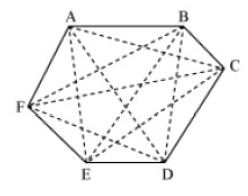
ANGLES
An angle is made up of two rays starting from a common end point.
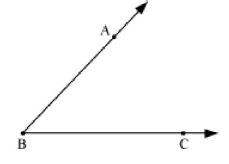
In this figure BA−→−BA→ and BC−→BC→ rays have one common end point, that is, B. The rays BA−→−BA→ and BC−→BC→ are called the arms or sides of the angle. The common end point B is the vertex of the angle.
We name the above angle as ∠∠BAC.
Triangle
TRIANGLES
A polygon made up of three line segments is called a triangle.
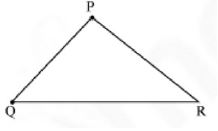
The triangle in the diagram is Δ∆PQR. Points P, Q and R are the vertices. PQPQ , QRQR and RPRP are the sides, and ∠∠PQR, ∠∠QRP, ∠∠RPQ are the angles of the triangle. A triangle has an interior and exterior.
Quadrilaterals
QUADRILATERALS
A quadrilateral is a four-sided polygon.
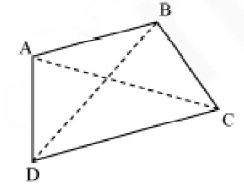
AC and BC are the diagonals of quadrilateral ABCD, ∠∠A and ∠∠C, and ∠∠B and ∠∠D are the opposite angles. ∠∠B and ∠∠C are the adjacent angles. Similarly, the other adjacent angles are ∠∠A and ∠∠B, ∠∠C and ∠∠D, ∠∠D and ∠∠A.
Circle and its parts
CIRCLES
A circle is formed by a point moving at the same distance from a fixed point. The fixed point is the centre of the circle. A circle is also a simple closed curve however; it does not have any sides or angles.
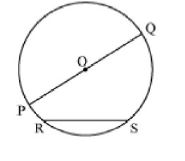
The fixed point O is the centre of the circle.
The fixed distance OP = OQ is the radius of the circle.
The distance around the circle is its circumference.
Circumference
The line that forms the boundary of a circle is called its circumference. The part enclosed by the circumference of a circle is called the interior of the circle. The part left outside the circle is said to be the exterior of the circle. Some points may lie on the circumference of the circle.
Radius
A line segment that joins the centre of the circle and a point on the circumference is called the radius of the circle. The radius of a circle is half of the diameter.
Chord
A chord is a line segment joining two points that lie on a circle.
Diameter
A chord passing through the centre of the circle is called its diameter. A diameter is the longest chord of a circle.
Arc
An arc is a part of the circumference of a circle.
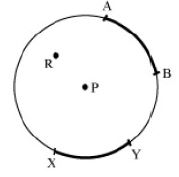
Sector
The part of a circle enclosed by two radii and an arc is called a sector.
Segment
The part of a circle that is enclosed by a chord and an arc is called a segment of the circle.
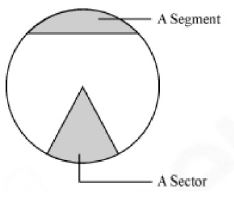
Semi-circle
A diameter of a circle divides it into two halves. Each half is called a semi-circle.

 Param Publication
Param Publication
 ReginaTagebücher
ReginaTagebücher
